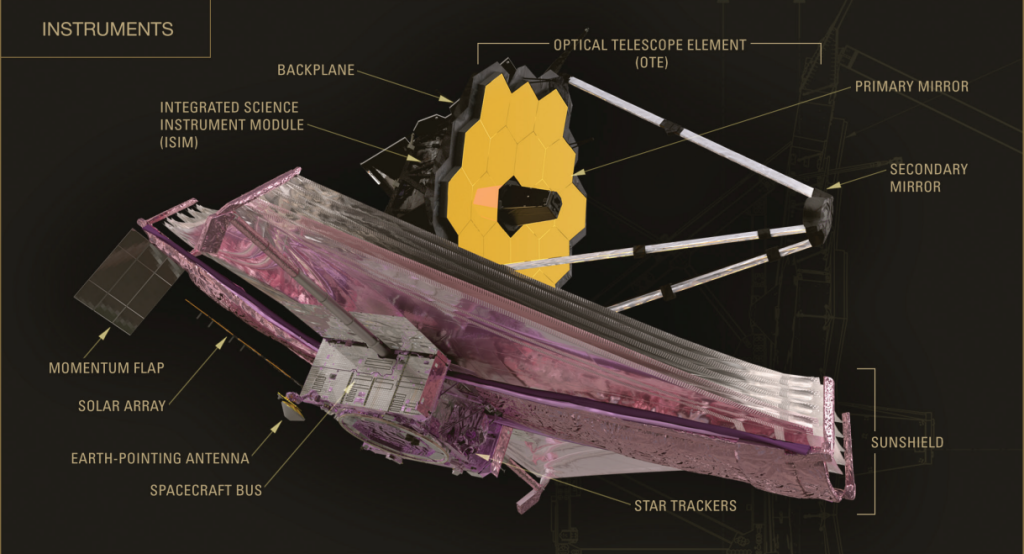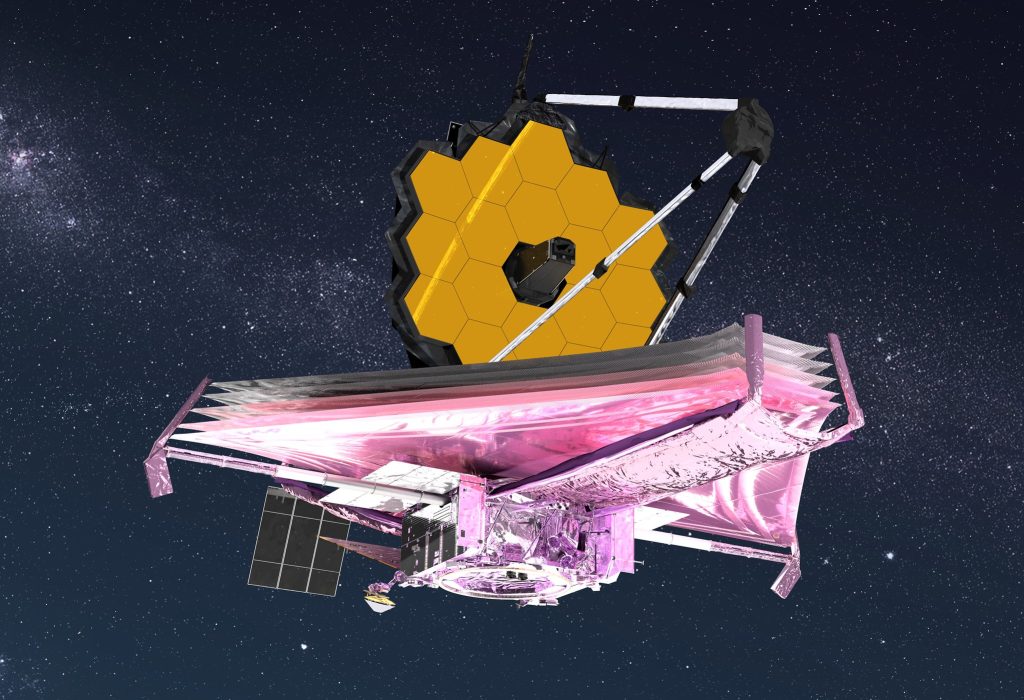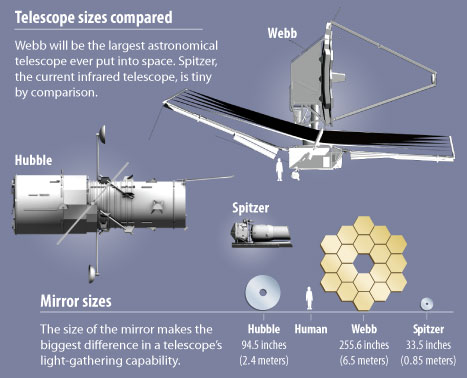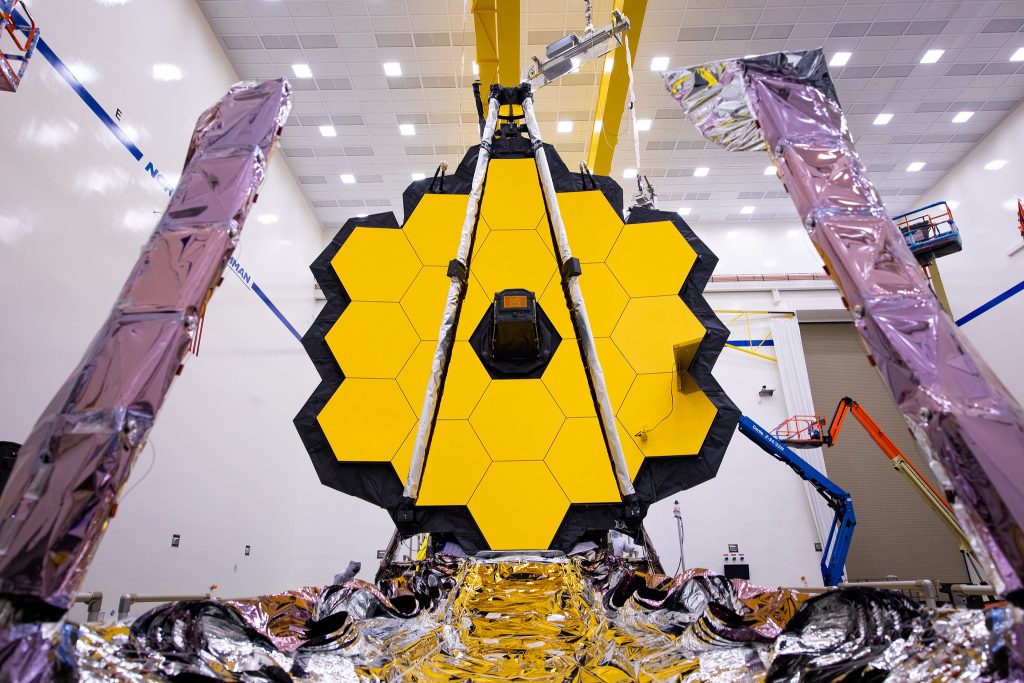WASHINGTON D.C., December 24, 2021 – The James Webb Space Telescope will be the world’s premier space science observatory when it launches Christmas Day, December 25, 2021, at 7:20 a.m. EST / 4:20 a.m. PST in French Guiana. Webb will solve mysteries in our solar system, look beyond to distant worlds around other stars, and probe the mysterious structures and origins of our universe and our place in it. Webb is an international program led by NASA with its partners, ESA (European Space Agency) and the Canadian Space Agency.
The rocket carrying the JWST is on the launch pad where the team will run electrical diagnostics to ensure all lights are green for launch. NASA, ESA, and Arianespace confirmed a targeted launch date of Saturday, Dec. 25, for the James Webb Space Telescope. The 32-minute launch window opens at 7:20 a.m. EST in Kourou, French Guiana (4:20 a.m. PST).

Construction on Webb began in 2004. In 2005, the European Space Agency’s Centre Spatial Guyanais (CSG) spaceport in French Guiana was chosen as the launch site and an Ariane 5 rocket as the launch vehicle. By 2011, all 18 mirror segments were finished and proven through testing to meet required specifications.
Between 2012 and 2013, Webb’s individual pieces, constructed in a variety of locations, began to arrive at NASA’s Goddard Space Flight Center in Greenbelt, Maryland. In 2013, construction of the sunshield layers began. From 2013 to 2016, Webb’s science instruments were packaged together and subjected to numerous tests of extreme temperature and vibration. From late 2015 to early 2016, the telescope optics and structures were assembled, featuring installation of all 18 of Webb’s individual mirrors on the telescope’s backplane structure to assemble the 21-foot (6.5-meter) mirror.

In 2017, the telescope assembly and the package of science instruments were integrated into one unit and subjected to mechanical integrity vibration testing at Goddard, then shipped to NASA’s Johnson Space Center in Houston, Texas, for end-to-end optical performance testing in a giant cryogenic temperature vacuum chamber.
In 2018, the performance-verified telescope plus instrument assembly was delivered to Northrop Grumman in Redondo Beach, California, where the spacecraft bus plus sunshield assembly was being built and tested, and the following year, these two halves of Webb were connected.
Final environmental, electrical, functional, and communications testing continued until Webb was folded and stowed for the final time in 2021.
Watch the launch live in the Nasa feed at the beginning of this article. Below are links to JWST resources:
What is the James Webb Space Telescope?

The James Webb Space Telescope is the largest and most
powerful space science telescope ever built. It is the scientific successor to
the iconic Hubble and Spitzer space telescopes, built to complement and further
the discoveries of Hubble, Spitzer, and other NASA missions by accessing the
near infrared and mid-infrared wavelengths with unprecedented resolution.

Webb’s revolutionary technology will allow scientists to explore every phase of cosmic history – from within our solar system to the most distant observable galaxies in the early universe, and everything in between. Webb will reveal new and unexpected discoveries and help humankind understand the origins of the universe, as well as our place in it.
Webb will begin gathering its first set of scientific
observations after its commissioning process is complete, roughly six months
after launch. The initial few weeks of commissioning includes Webb’s unfolding
process, which occurs as Webb is on its month-long, million-mile journey to its
operational orbit.

The observatory then gradually cools down to its cryogenic operating temperatures before we can safely operate the science instruments (about 40 kelvins, or less than -380 degrees Fahrenheit), and the commissioning team aligns all of its mirrors and calibrates its scientific instruments.
In order for Webb’s primary mirror segments to act as a single optic, each of the 18 segments must be aligned to within a fraction of a wavelength of near-infrared light, i.e., mere nanometers, or about 1/10,000th the thickness of a human hair!
Several new technologies were developed during the building of the Webb telescope, including innovative spinoffs that have already improved life here on Earth. Technological advances, and even new inventions, were necessary to make the mission feasible:
- Breakthrough lightweight deployable mirrors and advanced composite structures that align to millionths of millimeters and work at super-cold temperatures.
- Large, ultra-sensitive infrared light detectors.
- A “microshutter” device with thousands of tiny windows, each the width of a human hair and programmable to be open or closed, to enable spectroscopic measurement of hundreds of individual objects simultaneously.
- A cryocooler that chills the mid-infrared detectors to the necessary temperature of only a handful of degrees above absolute zero.
- Engineers developed a technique for precisely and rapidly measuring the mirrors to guide their grinding and polishing. This technology has since been adapted to creating high-definition maps of patients’ eyes for improved surgical precision for LASIK eye surgery.
International Collaboration
The James Webb Space Telescope is an international collaboration among NASA, the European Space Agency (ESA), and the Canadian Space Agency (CSA) including over 300 other contributors.
NASA is responsible for the overall Webb mission. NASA Headquarters oversees the program for the Science Mission Directorate. NASA’s Goddard Space Flight Center manages the entire Webb project, leads its overall engineering, and also produced components for the Integrated Science Instrument Module (ISIM). NASA’s Jet Propulsion Laboratory (JPL) managed the U.S. portion of the Mid-Infrared Instrument (MIRI), including the cryocooler. NASA’s Ames Research Center developed detector technology for the mission, while NASA’s Marshall Space Flight Center developed mirror technology and provided environmental research. NASA’s Johnson Space Center provided observatory test facilities. Lastly, NASA’s Glenn Research Center was involved in cryogenic component development.
ESA has provided the Near-Infrared Spectrograph (NIRSpec) instrument, as well as about half of the MIRI instrument through special funding from the ESA Member States. In addition, ESA is providing the launch vehicle — the Ariane 5 ECA rocket — and all launch services at Europe’s Spaceport in Kourou, French Guiana. In return, ESA scientists have a minimum share of 15% of the total observing time on the Webb telescope. ESA scientists will support mission operations at the Space Telescope Science Institute, and European scientists are also represented on all advisory bodies of the project.
CSA is contributing the Fine Guidance Sensor (FGS) and Near-Infrared Imager and Slitless Spectrograph (NIRISS) instrument. In exchange, Canadian Webb scientists will receive a guaranteed 450 hours of observing time in the first few years of the mission. About 5% of the General Observations program is also reserved for Canada. CSA scientists will support mission operations at the Space Telescope Science Institute, and Canadian scientists are also represented on all advisory bodies of the project.
Content Source: JWST Media Kit
Editor’s Note: From 2007 to 2010, Mario Lotmore, owner and publisher of the Lynnwood Times, was the principal Industrial Engineer and Assistant Project Manager for the manufacturing build of the 18 beryllium mirrors for the JWST during his tenure at L3 Communication Tinsley Labs.
Author: Mario Lotmore









